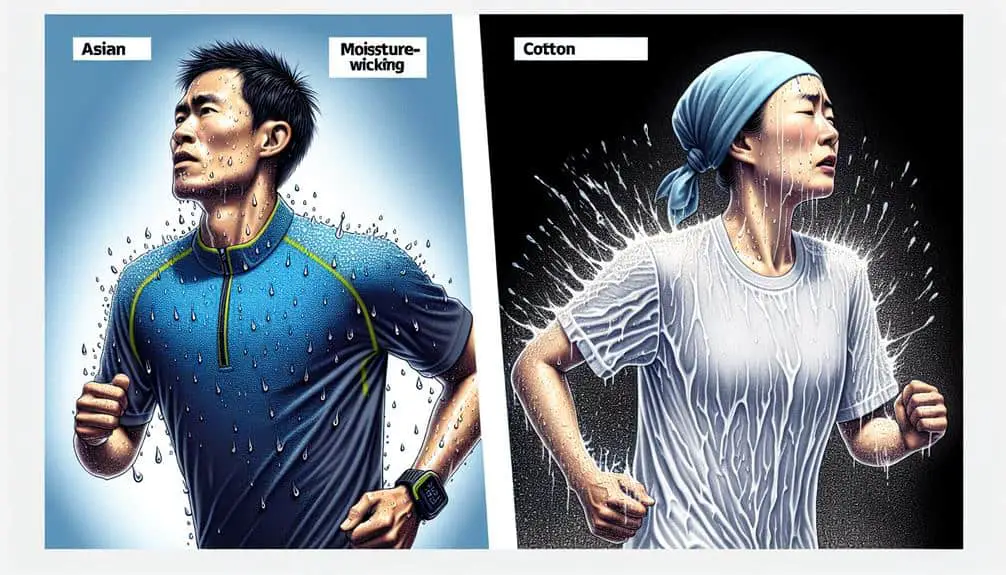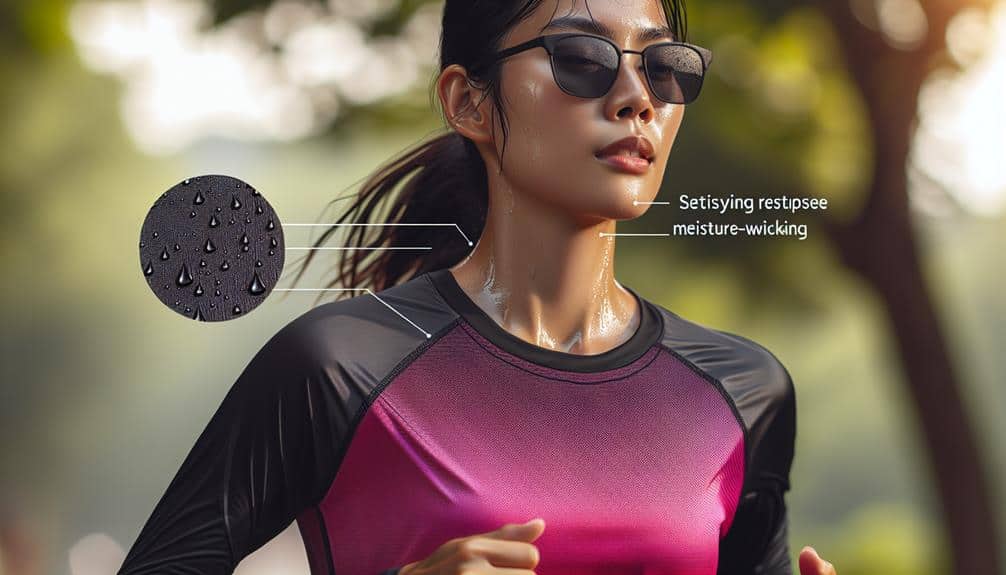For superior sweat absorption in your running gear, opt for moisture-wicking fabrics like bamboo, modal, or synthetic blends. Look for breathable materials that draw sweat away from your skin to keep you dry and comfortable. Cotton alternatives provide good absorption, while synthetic blends add durability. Proper care, like using sports-specific detergent and avoiding fabric softeners, maintains the effectiveness of these materials. To maximize your moisture control, stay hydrated and choose lightweight, breathable clothing. Enhance your running experience with the best sweat-absorbing materials to optimize your performance and comfort.
Key Points
- Look for moisture-wicking properties in fabrics to keep skin dry and comfortable.
- Choose breathable materials like bamboo or modal for effective sweat absorption.
- Opt for synthetic blends such as polyester-spandex for durability and moisture control.
- Follow care instructions to maintain the sweat-wicking abilities of your apparel.
- Use hydration strategies and cooling techniques to enhance moisture control during runs.
Benefits of Moisture Wicking Shirts
Moisture-wicking shirts enhance your running experience by efficiently drawing sweat away from your skin, keeping you dry and comfortable throughout your workout. The performance benefits of moisture-wicking shirts lie in their fabric technology, which utilizes specialized materials to pull moisture away from your body and disperse it across the fabric's surface, allowing for quicker evaporation. This process helps regulate your body temperature by preventing the accumulation of sweat, reducing the risk of chafing, and enhancing overall comfort during physical activity.
Fabric technology in moisture-wicking shirts typically involves synthetic materials like polyester or polypropylene, engineered to have capillary action. This means the fabric can rapidly absorb and transport moisture to the outer layer for evaporation, leaving your skin feeling dry. By incorporating these advanced fabric technologies, moisture-wicking shirts optimize your performance by maintaining a dry and breathable environment, reducing the likelihood of skin irritations, and supporting your focus and endurance during intense workouts.
Features to Look for in Materials
When selecting materials for running apparel, key features to take into account include their ability to efficiently manage moisture, regulate body temperature, and enhance overall comfort during physical activity.
A breathable design is vital in sweat-absorbing materials as it allows moisture to escape, keeping you dry and preventing chafing. Look for fabrics with moisture-wicking properties that draw sweat away from your skin to the outer surface where it can evaporate quickly.
Additionally, materials with a comfortable fit are essential for runners to prevent irritation and discomfort during workouts. Fabrics that offer a stretchy and soft feel can enhance your range of motion and provide a snug yet non-restrictive fit.
Top Sweat-Absorbing Fabric Choices
Choosing the most effective sweat-absorbing fabrics for your running apparel requires a keen understanding of their moisture management capabilities and comfort-enhancing features. When it comes to top sweat-absorbing fabric choices, two main categories stand out: cotton alternatives and synthetic blends.
Cotton alternatives like bamboo and modal are excellent choices for runners looking for natural fibers that offer good sweat absorption. Bamboo fabric is known for its softness, breathability, and moisture-wicking properties, making it a comfortable option for long runs. Modal, derived from beech trees, is another cotton alternative that's lightweight, breathable, and has excellent moisture-wicking abilities.
On the other hand, synthetic blends such as polyester-spandex or nylon-polyester are popular for their moisture-wicking properties and durability. These fabrics are designed to pull moisture away from the skin to the outer surface of the fabric where it can evaporate quickly, keeping you dry and comfortable during your runs.
Consider these top sweat-absorbing fabric choices when selecting your running apparel to promote excellent performance and comfort.
How to Maintain Sweat-Wicking Apparel
To properly care for your sweat-wicking apparel and maintain its performance over time, follow these essential maintenance guidelines.
When it comes to cleaning techniques, always check the care instructions on the garment label. Most sweat-wicking materials can be machine washed in cold water and tumble dried on low heat. Avoid using fabric softeners or bleach, as these can clog the fabric's pores and reduce its moisture-wicking abilities. To prevent odors, consider using a sports-specific detergent that's designed to remove sweat and bacteria effectively.
Proper storage is also vital for maintaining your sweat-wicking apparel. Make sure the garments are completely dry before storing them to prevent mildew or odors from developing. Avoid storing them in plastic bags or airtight containers, as this can trap moisture and promote bacterial growth. Instead, opt for breathable storage options like mesh bags or hanging them in a well-ventilated area.
Tips for Maximizing Moisture Control
For best moisture control during your runs, choose apparel made from high-performance sweat-wicking materials designed to keep you dry and comfortable. To maximize moisture control, consider implementing effective hydration strategies and cooling techniques.
Hydration plays an important role in regulating your body temperature and sweat production. Make sure to drink an adequate amount of water before, during, and after your run to maintain ideal hydration levels. Electrolyte-rich drinks can also help replenish lost minerals due to sweating.
Additionally, cooling techniques can aid in managing moisture during your runs. Wearing lightweight and breathable clothing allows for better air circulation, aiding in sweat evaporation. Opt for garments with mesh panels or ventilation features to enhance airflow. Choosing light-colored apparel can also help reflect sunlight and reduce heat absorption, keeping you cooler and less prone to excessive sweating. Be mindful of running in shaded areas or during cooler times of the day to minimize heat exposure and perspiration.
Frequently Asked Questions
Are There Any Specific Care Instructions for Sweat-Wicking Apparel When Washing and Drying?
When washing and drying moisture-wicking clothing, follow fabric care instructions to maintain longevity. Treat stains promptly for effective removal and guarantee odor control. Proper care guarantees top performance and durability of your sweat-absorbing gear.
Can Sweat-Wicking Materials Help Prevent Chafing During Long Runs?
To prevent chafing during long runs, sweat-wicking materials are essential. The benefits of these fabrics include superior moisture management, reducing friction, and enhancing overall performance. Athletes rely on such textiles for comfort and best results.
Do Different Sweat-Wicking Fabrics Have Varying Levels of Breathability?
Feeling the breeze through your fabric as you run? Different sweat-wicking fabrics vary in breathability levels. Understanding fabric performance is key for peak moisture management during your runs. Stay cool and dry!
Are There Any Environmental Considerations to Take Into Account When Choosing Sweat-Absorbing Materials?
When selecting sweat-absorbing materials, consider environmental impact. Opt for sustainable options like bamboo or recycled polyester. These eco-friendly choices reduce harm to the environment. Embrace green alternatives that align with your ethos.
Can Sweat-Wicking Shirts Be Worn in Extreme Weather Conditions, Such as During Cold or Hot Weather?
You want to know if sweat-wicking shirts are suitable for extreme weather. In cold, layering options can help with insulation needs. For hot weather, consider fabric durability and comfort levels to stay cool and dry.




